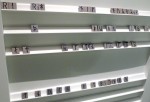 The National Museum of Scotland’s Vikings!: The Untold Story exhibition has more than 500 artifacts from the permanent collection of the Swedish History Museum in Stockholm which have rarely been seen outside of Scandinavia. The exhibition takes an innovative approach to showing how the Vikings lived, with interactive digital displays and replicas that allow visitors to touch and play with Viking culture. The aim is to dispel the intensely bellicose image of the Norsemen and to show how Scandinavians in the Viking Age, most of whom were farmers and traders rather than warriors, lived.
The National Museum of Scotland’s Vikings!: The Untold Story exhibition has more than 500 artifacts from the permanent collection of the Swedish History Museum in Stockholm which have rarely been seen outside of Scandinavia. The exhibition takes an innovative approach to showing how the Vikings lived, with interactive digital displays and replicas that allow visitors to touch and play with Viking culture. The aim is to dispel the intensely bellicose image of the Norsemen and to show how Scandinavians in the Viking Age, most of whom were farmers and traders rather than warriors, lived.
The coolest exhibit, I think, is a half of a Viking ship recreated with 1200 metal rivets strung on translucent spidery threads that replicate the shape of the vessel. The ship’s planks covered the grave of a wealthy man of status on Orkney. None of the wood survived; only the rivets were still there when the burial was excavated. They made marvelous lemonade out of the limited survival, creating a piece that is downright otherworldly and that can travel easily and safely in a way that a thousand-year-old wooden boat could not even if it had survived.
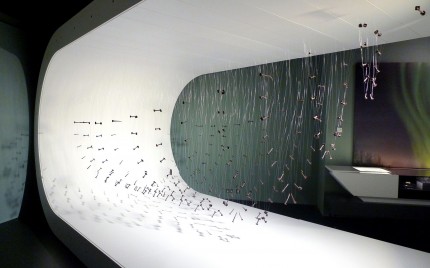
Is that not brilliant? I love how the rivets are angled as they would have been in the wood. It conveys not just the dimensions of the ship, but also exposes the technical carpentry skill that you couldn’t see if the ship were complete.
The high quality of Scandinavian craftsmanship is a recurring theme in this exhibition. In the sagas there are references to the gods being smiths or craftsmen. The transformation of metal into weapons and other objects was considered a fundamental alteration to the created world. Craftsmen therefore had rituals to perform as they worked to ensure their work was in keeping with the magic and deities of their world.
The jewelry and work in precious metals is as impressive as you would expect, but even the daily use objects are incredibly intricate and beautiful. These are keys:

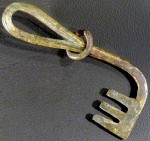

These were household keys, not the unlockers of mystical treasure. They would be worn as part of her garments by the wife and mother who was in charge of the home. Their intricacy underscores this was a position of pride and importance. Can you imagine having a few of those on a ring clipped to your belt? We’ve lost a lot in our era of Ace Hardware keys made while you wait.
Viking daily life is represented by all kinds of beautifully detailed artifacts, some of them rare survivals. There’s a woven textile embroidered with a stag, wooden board games, an ironing board (maybe slate?) with the large smooth stone used to iron, an engraved folding comb carved out of bone that would honor the pocket of even the most discriminating 50s greaser stereotype.
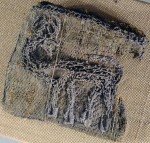
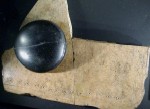
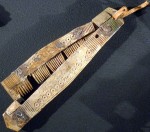
They even have bread loaves that appear to have survived thanks to carbonization, like the bread from Herculaneum. The Viking bread found in Birka, Sweden, was analyzed and the likely recipe recreated. It’s ridiculously healthy, made primarily from barley flour and including flax seeds. If you’d like to try your hand at making it yourself, here’s the recipe:
Viking Bread
About 150 g barley flour
About 50 g wholemeal flour
2 tsp crushed flax seeds
About 100 ml water
2 tsp lard or butter
A pinch of saltWork all the ingredients together into a dough and knead. If the dough is too wet or hard, add flour or water. Let the dough rest cold for at least one hour, preferably longer.
Shape the dough into flat cakes (about 1/2cm thick). Bake them in a dry cast iron pan on the stove over medium heat, a few minutes on each side, or in the oven at 150 degrees, for 10–13 minutes.
The exhibition runs from January 18th to May 12th. I’m afraid I can’t find a list of the other stops in the tour, but I know it spent last year in Northern Europe and this is its only stop in the UK. The National Museum of Scotland has an excellent collection of pictures of the Vikings! exhibit on its Flickr page.
For more details about Viking life, the artifacts on display and the brilliantly futuristic, Star-Trek looking design of the exhibit which was actually inspired by Viking iconography, see the exhibition page on the Swedish History Museum’s website.
Lovely. Thank you.
Riveting, even? 😉
Was this ‘viking bread’ really made w/o sourdough or yeast ? Was it by any chance served with stuff like ‘hákarl’ or ‘lutefisk’ ?
An old viking friend of mine from Denmark once told me that the basic idea about ‘hákarl with bread’ was to consume large quantities of ‘snaps’ with it.
Referring to lutefisk, “we tried the lutefisk trick and the raccoons went away, but now we’ve got a family of Norwegians living under our house!”.
They definitely look rounded, like some sort of leavener was involved. Perhaps the bread in the picture is not the bread that was analyzed for its recipe? How much Viking bread can possibly have survived?
😆 @ the family of Norwegians.
Very lovely, thank you for posting!
On the Flicker page, I saw a brooch of bronze, gold and garnet that was strikingly similar to the Staffordshire Hoard. Wonder if it was traded?
I know the piece you mean, and yes it does look quite Staffordshirey thanks to the gold and garnets. It could have been traded or been locally produced but influenced by Saxon style.
Ho! Ho!
I wondered about leavening, as well.
I’ll email the museum to see if they can answer the question. I’m guessing the bread that was tested to make the recipe and the bread on display is not the same.
How much we have lost by having mass-produced “utilitarian” household objects! Having keys like that would make you smile every time you opened your front door, and the folding comb just gave me goosebumps; talk about deja vu, you can see similar combs disguised as switchblades in catalogs. Can you imagine the archaeologist who dug up that comb, how thrilled they must have been to find such a familiar object from so long ago. And ugh, even that long ago they had to do ironing – I always thought that time-wasting bull was only a couple hundred years old.
I think I saw a dingle-schtay, dengle-stock, (“dangle-stock”?) in the Swedish Museum site. The small hammer/wedge-shaped anvil combo, which dangled from the belt, used by early farmers for sharpening their scythe-blades, was brought to America by early central-Europeans…maybe Vikings used them?